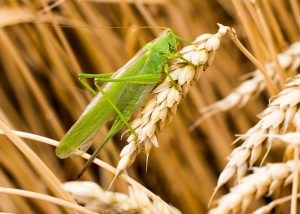Spring and summer backyards often buzz with life, and among the most noticeable creatures are bright green grasshoppers hopping energetically through the greenery. These medium to large insects, characterized by their two pairs of wings and powerful hind legs built for leaping, are equipped with specialized mouthparts – mandibles and molars – designed for cutting and grinding. But what exactly are they grinding? Delving into the question, What Do Grasshoppers Eat? reveals a fascinating aspect of their biology and their role in the ecosystem. Let’s explore the dietary habits of these common insects.
The Herbivorous Appetite of Grasshoppers
Grasshoppers are predominantly herbivores, meaning their diet primarily consists of plants. When presented with a buffet of vegetation, grasshoppers exhibit a preference for cultivated crops. Fields of rye, barley, cotton, corn, alfalfa, and wheat are particularly attractive to them. These crops, often rich in nutrients and easily accessible in agricultural landscapes, become a primary food source for many grasshopper species.
From a farmer’s perspective, grasshoppers can be unwelcome guests. Their voracious appetite leads them to consume significant amounts of crops daily – remarkably, a grasshopper can eat up to 16 times its own body weight in plant material each day. This feeding intensity can result in substantial agricultural damage, impacting crop yields and causing economic concerns for farmers. Understanding what grasshoppers eat is crucial for developing effective pest management strategies in agricultural settings.
However, grasshoppers are not strictly limited to these preferred crops. Their dietary flexibility allows them to survive in various environments. When their favorite grains are scarce, grasshoppers readily adapt and consume a wider range of plant matter. Grasses, flowers, and leaves become alternative food sources, ensuring their survival even when cultivated crops are unavailable. In more challenging situations, where even these options are limited, grasshoppers demonstrate remarkable adaptability by resorting to less nutritious food sources such as moss, fungi, and bark. This ability to consume less desirable plant material underscores their resilience and capacity to thrive in diverse conditions, even when optimal food sources are lacking.
Grasshoppers as Part of the Food Chain: What Eats Them?
Despite their size and plant-based diet, grasshoppers occupy a lower rung on the food chain, making them a valuable food source for numerous predators. A variety of animals prey on grasshoppers, including birds, snakes, mice, frogs, and lizards. These predators play a vital role in regulating grasshopper populations and maintaining ecological balance.
Interestingly, grasshoppers possess a defense mechanism to deter predators. Some species consume toxic plants and store the toxins within their bodies. This sequestration of toxins makes them less palatable or even poisonous to potential predators, providing a degree of protection against being eaten. This fascinating adaptation highlights the complex interactions between grasshoppers, their diet, and their predators within the ecosystem.
Grasshopper vs. Cricket: Dietary Differences
Grasshoppers share a distant relation with crickets, another group of hopping insects. While both possess strong hind legs for jumping, significant differences exist, particularly in their dietary habits. Unlike the primarily herbivorous grasshopper, crickets are omnivores. Their diet is more diverse, encompassing both plant and animal matter. Crickets consume insect larvae, aphids, grasses, leaves, seeds, fruit, flowers, and even decaying plant matter. This broader diet reflects their different ecological niches and feeding strategies.
Beyond diet, other distinctions separate grasshoppers and crickets. Grasshoppers are generally larger and often green, providing camouflage in grassy environments, whereas crickets are typically smaller and darker in color, often black or brown. Furthermore, grasshoppers are diurnal, actively feeding during daylight hours, while crickets are nocturnal, famously chirping throughout the night. These differences in diet, appearance, and behavior illustrate the diverse adaptations within the insect world.
Understanding what do grasshoppers eat offers valuable insights into their life cycle, ecological role, and interactions within their environment. From their preferred plant-based diet to their position as prey in the food chain, grasshoppers are fascinating creatures that play a significant part in many ecosystems.

